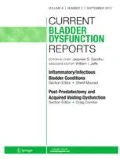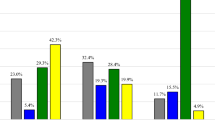Abstract
Urethral stricture is a common cause of morbidity and sometime mortality in West Africa. A variety of investigative tool and techniques are currently available to evaluate and manage this condition. Major urological societies have issued evidence based guidelines for the evaluation and management of this disease. In Ghana and West Africa the resources available in the developed world may not be available. The patient population is different with most patients presenting with complications like acute urinary retention. Therefore evidence based guidelines may not be strictly adhered to. We performed a retrospective audit of the evaluation and management of urethral stricture at Korle Bu Teaching hospital in Accra Ghana between November 2011 and November 2012 and compared our findings with published studies from the sub region. Post inflammatory strictures predominate but the percentage is decreasing due to the rapid increase in the incidence of pelvic fracture urethral injury. To reduce the cost of investigation a thorough history and physical examination is essential, imaging tests performed are those that will influence management plan. Although urethrotomy and dilatation are not curative, patients who otherwise would have benefited from urethroplasty are still offered repeated urethrotomy because of lack of theatre space and trained surgeons to perform urethroplasty. For the same reason many patients in the sub region spend many months to years with a suprapubic catheter.




Similar content being viewed by others
References
Papers of particular interest, published recently, have been highlighted as: • Of importance
Khalid L, Mbibu NH, Nwofor AME. Spectrum of urologic disease in the west african subregion. Ann African Med. 2002;1:44–52.
Fall B, Sow Y, Mansouri I, Sarr A, Thiam A, Diao B, et al. Etiology and current clinical characteristics of male urethral stricture disease: experience from a public teaching hospital in Senegal. Int Urol Nephrol. 2011;43:969–74.
Lumen N, Hoebeke P, Willemsen P, De Troyer B, Pieters R, Oosterlinck W. Etiology of urethral stricture disease in the 21st century. J Urol. 2009;182:983–7.
Ntia IO, Mungadi IA. Management of watering-can’' perineum. East African Med J. 2007;84:283–6.
Dalela D, Goel A, Gupta A. Antegrade urethrogram:a technique to visualize the proximal bulbous urethral segment in anterior urethral stricure. Ind J Urol IJU J Urol Soc India. 2008;25:419–6.
Gupta N, Dubey D, Mandhani A, Srivastava A, Kapoor R, Kumar A. Urethral stricture assessment: a prospective study evaluating urethral ultrasonography and conventional radiological studies. BJU Int. 2006;98:149–53.
Ikuerowo SO, Ogunade AA, Ogunlowo TO, Uzodimma CC, Esho JO. The burden of prolonged indwelling catheter after acute urinary retention in Ikeja - Lagos, Nigeria. BMC Urol. 2007;7:16.
Mensah JE, Quartey JKM, Yeboah ED. The efficacy of intracorpus spongiosum anesthesia in internal urethrotomy for anterior urethral strictures. Afr J Urol. 2005;11:111–4.
Dubey D. The current role of direct vision internal urethrotomy and self-catheterization for anterior urethral strictures Duration of Catheterization after DVIU DVIU: results long-term efficacy of DVIU factors associated with stricture recurrence does stricture E. Indian J Urol. 2011;27:392–6.
Whitaker P, Heyns CF, Steenkamp JW, De Kock MLS. Treatment of male urethral strictures:is repeated dilation or internal urethrotomy useful. J Urol. 1998;160:356–8.
• Saigal CS, Anger JT, Buckley JC, Santucci RA, Elliott SP, U.D. in A.P. Trends in stricture management among male medicare beneficiaries: underuse of urethroplasty. Urology. 2011;77:481–5. This was the study that showed that patients who would have been cured by urethroplasty are still offered urethrotomy.
Heyns CF, Van Der Merwe J, Basson J. Treatment of male urethral strictures – possible reasons for the use of repeated dilatation or internal urethrotomy rather than urethroplasty. S Afr J Surg. 2012;50:82–7.
Andrich DE, Mundy AR. What’s new in urethroplasty? Curr Opin Urol. 2011;21:455–60.
Barbagli G, Sansalone S, Djinovic R, Romano G, Lazzeri M. Current controversies in reconstructive surgery of the anterior urethra: a clinical overview. Int Braz J Urol. 2012;38:307–16.
Wani BN, Jajoo SN, Bhole AM. Outcome of urethral strictures managed by general surgeons in a rural setting of India. Indian J Surg. 2011;73:336–40.
• Mundy AR, Andrich DE. Urethral strictures. BJU Int. 2011;107:6–26. This is an excellent and comprehensive review of urethral stricture disease. It discusses the management of urethral stricture in an easy to read and practical manner.
Osegbe D, Tijani KH, Adesanya AA, Ogo CN. Penile fasciocutaneous flap urethroplasty: recent experi-ence and challenges in a Sub-Saharan African teaching hospital. Urology. 2009;74:290–923.
Quartey J. One-stage penile/ preputial island flap urethroplasty for urethral stricture. J Urol. 1985;134:474–5.
Palminteri E, Barbagli G, Selli C, Tosto A. Dorsal free graft urethroplasty. J Urol. 1991;155:123–6.
Lumen N, Hoebeke P, Oosterlinck W. Urethroplasty for urethral strictures: quality assessment of an in-home algorithm. Int J Urol Off J Jpn Urol Assoc. 2010;17:167–74.
Eltahawy EA, Virasoro R, Schlossberg SM. Long term follow up for excision and primary anastomosis for anterior urethral strictures. J Urol. 2007;177:1803–6.
Webster GD, Guralnick ML. The augmented anastomotic urethroplasty. Indications and outcome in 29 patients. J Urol. 2001;165:1496–501.
Peterson AC, Webster GD. Management of urethral stricture disease: developing options for surgical intervention. BJU Int. 2004;94:971–6.
Mante SD, Klufio GO, Yeboah ED, Yegbe P, Gepi Atee S, Mensah JE, et al. The pattern, management and outcome of genitourinary trauma in Ghana. Postgrad Mendical J Ghana. 2013;2:2–6.
Afukaar AFK, Antwi P. Pattern of road traffic injuries in Ghana: implications for control. Inj Cont Safe Promot. 2003;10:69–76.
Mundy AR, Andrich DE. Urethral trauma. Part II: types of injury and their management. BJU Int. 2011;108:630–50.
Frontera JR, Gheiler EL. Immediate primary realignment of prostatomembranous urethral disruptions using endourological techniques. Urology. 1997;49:596–9.
Mundy AR, Andrich DE. Urethral trauma. Part I: introduction, history, anatomy, pathology, assessment and emergency management. BJU Int. 2011;108:310–27.
Balkan E, Kilic N, Dogruyol H. The effectiveness of early primary realignment in children with posterior urethral injury. Int J Urol Off J Jpn Urol Assoc. 2005;12:62–6.
Shrinivas RP, Dubey D. Primary urethral realignment should be the preferred option for the initial management of posterior urethral injuries. Indian J Urol. 2010;26:310–3.
Olapadeâ E, Olaopa. Early endoscopic realignment of traumatic anterior and posterior urethral disruptions under caudal anaesthesia–a 5 year review. J Clin Pract. 2010;64:6–12.
Webster GD, Ramon. Repair of pelvic frac-ture posterior urethral defects using an elabo-rated perineal approach. Experience with 74 cases. J Urol. 1991;145:744–8.
Conflict of Interest
James Edward Mensah declares that he has no conflict of interest.
Emmanuel Kweku Asante declares that he has no conflict of interest.
Mathew Yamoah Kyei declares that he has no conflict of interest.
Bernard Toboh declares that he has no conflict of interest.
Author information
Authors and Affiliations
Corresponding author
Rights and permissions
About this article
Cite this article
Mensah, J.E., Asante, E.K., Kyei, M.Y. et al. Contemporary Evaluation and Treatment of Male Urethral Stricture Disease in West Africa. Curr Bladder Dysfunct Rep 8, 108–113 (2013). https://doi.org/10.1007/s11884-013-0185-8
Published:
Issue Date:
DOI: https://doi.org/10.1007/s11884-013-0185-8




